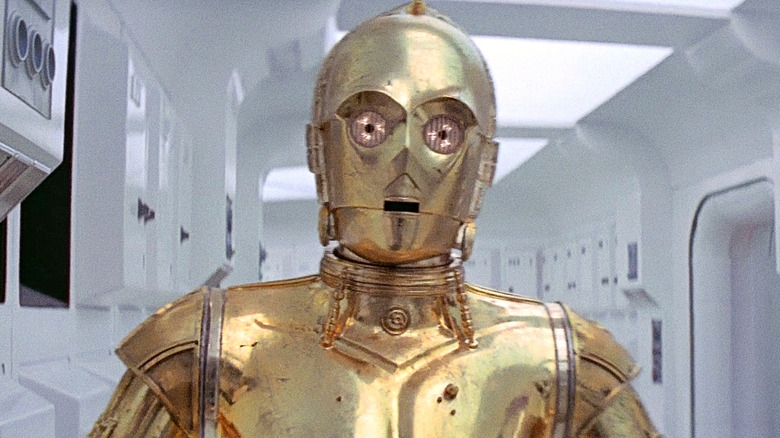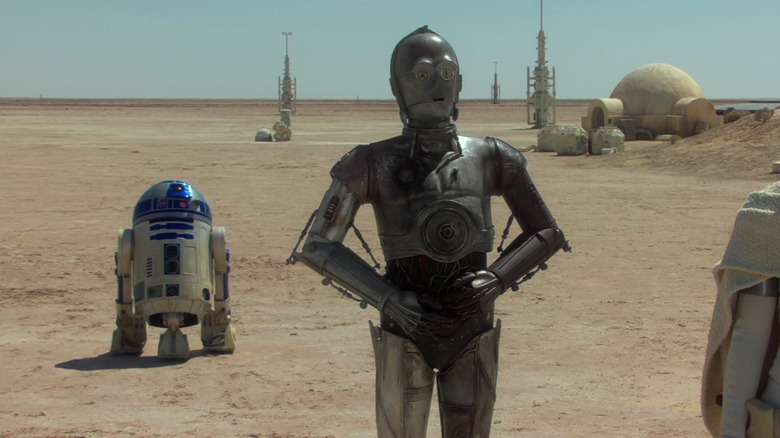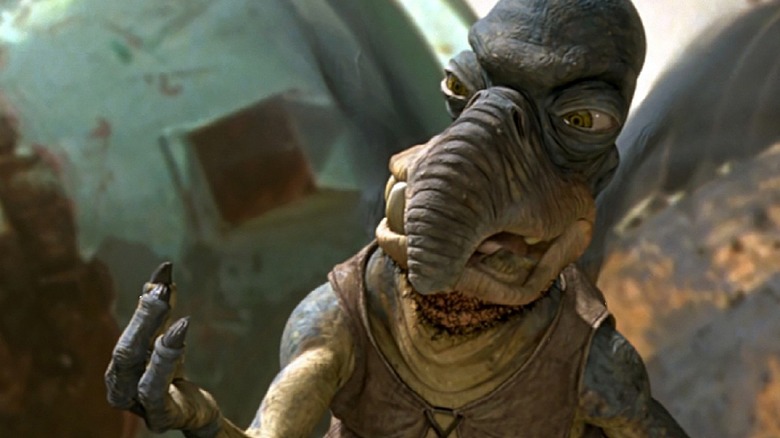Star Wars' C-3PO Was Originally Written A Lot More Like Watto
The most rudimentary research into the creative origins of the groundbreaking 1977 sci-fi flick "Star Wars" will reveal to the reader that creator George Lucas was inspired by "Flash Gordon" serials from the 1930s, as well as Akira Kurosawa's 1958 epic "The Hidden Fortress." Kurosawa's film famously opened with two clownish characters (Kamatari Fujiwara and Minoru Chiaki) who aimed to earn their fortune as samurai. After several misadventures, the peasants unwittingly become embroiled in a much larger plot about a missing princess (Misa Uehara), a war, and a brave protective warrior (Toshiro Mifune). "Star Wars" borrowed that film's structure, introducing audiences to its sci-fi action through the eyes (lenses?) of the robotic characters C-3PO (Anthony Daniels) and the non-humanoid R2-D2 (physically operated by Kenny Baker, electric vocals by Ben Burtt).
C-3PO was a prissy, fastidious droid who seemed impatient with the foibles of the organic beings he lived with, and was frequently panicked and afraid. The only time he seemed in his element was when he was translating alien languages; he was, after all, a protocol robot built for that very purpose. R2-D2, meanwhile, was essentially a moving Swiss Army Knife, handy with minor repairs and also starship navigation. Given how C-3PO responded to R2-D2's beeping noises, one might infer that the little robot was brusque, perhaps even crass. It's easy to imagine that R2 was unleashing a fusillade of ultra-nasty cuss words in its weird android language.
According to John Philip Peecher's 1983 book "The Making of Star Wars: Return of the Jedi," however, C-3PO wasn't always so priggish. Indeed, he was originally conceived as a slimy, smooth-talking used-car-salesmanlike robot with an American accent. It wasn't until Lucas realized he was working with so many Brits that he altered the character.
A Very British Droid
"Star Wars" features two notable British actors in prominent roles. There was Sir Alec Guinness as the wise old wizard Obi-Wan Kenobi, and there was Peter Cushing as Grand Moff Tarkin, the film's central villain. Lucas noticed that the "heroes" and the "villains" alike had both American and English accents, and he wanted to make sure that he spread the love, so to speak. To quote:
"I also tried very carefully to balance the British and American voices so that both the good guys and the bad guys sounded English and American. Alec Guinness and Peter Cushing had sort of mid-Atlantic accents, not strongly British. Tony Daniels had the most British accent of them all, so originally I said no to his playing C-3PO. I wanted to make C-3PO American because he is one of the lead characters. Threepio's voice should be slightly more car-dealerish, a little more oily. I had the idea of a con man, which is the way it was written, and not really a sort of fussy British robot butler."
Given that "Star Wars" already contained a character like Han Solo (Harrison Ford) — a slick-talking, roguish smuggler — perhaps a car dealer android would have been one toke over the line. Or perhaps Lucas intended to alter Han Solo to more carefully balance C-3PO. Ultimately, Daniels provided the best audition for the role, and Lucas felt he had no choice. He found the droid he was looking for. He said, "We went through 30 people whom I actually tested, but none of the voices were as good as Tony's because Tony WAS Threepio inside; he really got into the role, so I kept him."
Watto
Evidently, however, Lucas couldn't let the idea go. He seemingly wanted a slimy car dealer in a "Star Wars" movie, come hell or high water. Starwoids the world over might immediately be thinking of Watto (Andy Secombe), the slave-owning freelance merchant from Lucas' 1999 film "Star Wars: Episode I – The Phantom Menace." Watto was a diminutive, winged humanoid tapir who bought and sold vehicle parts for a living. He also owned Shmi Skywalker (Pernilla August) and her young son Anakin (Jake Lloyd), later known as Darth Vader. He smooth-talked the people in his shop and tapped into classic salesman's language, i.e., "no one else in town has this part."
Laurent Bouzereau's and Judy Duncan's book "The Making of Star Wars, Episode I – The Phantom Menace" featured an interview with Rob Coleman, the film's animation director, and he briefly mentioned the way George Lucas described the character of Watto. Evidently, Lucas wanted him to be a "sleazy car dealer, a pirate, a gambler." Coleman was interested in animating the character correctly, so asked if Watto was from the desert planet Tatooine, where all his scenes take place. Lucas said that yes, he was, and was comfortable with the dry heat.
Sadly, due to a confluence of character archetypes, performance, and animation, Watto emerged in "The Phantom Menace" with some accusations of possessing antisemitic characteristics. J. Hoberman noted in the Village Voice that Watto — and several other characters — evoked certain ethnic stereotypes. "Although Jar Jar can be construed as grotesquely Third World and the fish faces talk like Fu Manchu," he said, "the most blatant ethnic stereotype is the hook-nosed merchant insect who owns young Anakin." Ouch. C-3PO would never.
Secombe, meanwhile, felt he was affecting an Italian accent.


